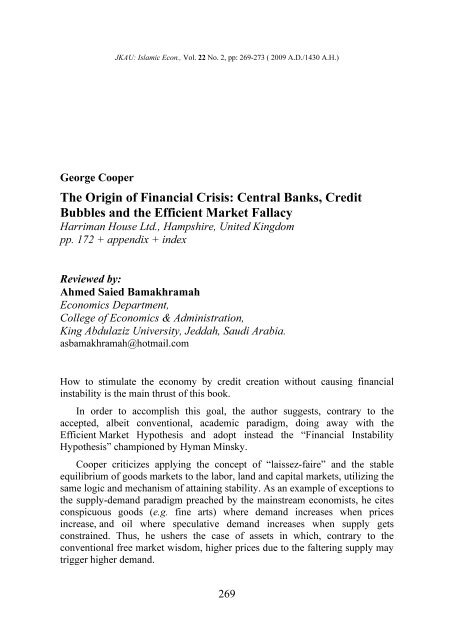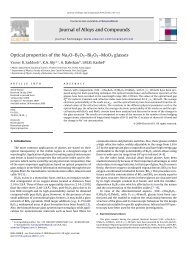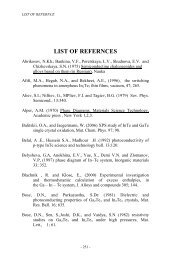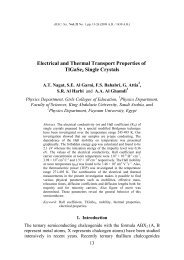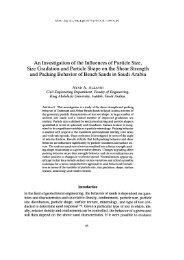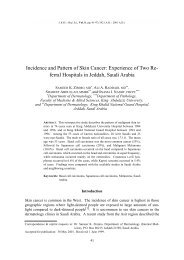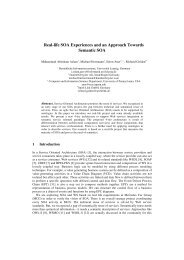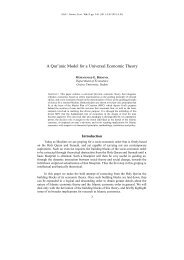The Origin of Financial Crisis: Central Banks, Credit Bubbles and the ...
The Origin of Financial Crisis: Central Banks, Credit Bubbles and the ...
The Origin of Financial Crisis: Central Banks, Credit Bubbles and the ...
You also want an ePaper? Increase the reach of your titles
YUMPU automatically turns print PDFs into web optimized ePapers that Google loves.
JKAU: Islamic Econ., Vol. 22 No. 2, pp: 269-273 ( 2009 A.D./1430 A.H.)<br />
George Cooper<br />
<strong>The</strong> <strong>Origin</strong> <strong>of</strong> <strong>Financial</strong> <strong>Crisis</strong>: <strong>Central</strong> <strong>Banks</strong>, <strong>Credit</strong><br />
<strong>Bubbles</strong> <strong>and</strong> <strong>the</strong> Efficient Market Fallacy<br />
Harriman House Ltd., Hampshire, United Kingdom<br />
pp. 172 + appendix + index<br />
Reviewed by:<br />
Ahmed Saied Bamakhramah<br />
Economics Department,<br />
College <strong>of</strong> Economics & Administration,<br />
King Abdulaziz University, Jeddah, Saudi Arabia.<br />
asbamakhramah@hotmail.com<br />
How to stimulate <strong>the</strong> economy by credit creation without causing financial<br />
instability is <strong>the</strong> main thrust <strong>of</strong> this book.<br />
In order to accomplish this goal, <strong>the</strong> author suggests, contrary to <strong>the</strong><br />
accepted, albeit conventional, academic paradigm, doing away with <strong>the</strong><br />
Efficient Market Hypo<strong>the</strong>sis <strong>and</strong> adopt instead <strong>the</strong> “<strong>Financial</strong> Instability<br />
Hypo<strong>the</strong>sis” championed by Hyman Minsky.<br />
Cooper criticizes applying <strong>the</strong> concept <strong>of</strong> “laissez-faire” <strong>and</strong> <strong>the</strong> stable<br />
equilibrium <strong>of</strong> goods markets to <strong>the</strong> labor, l<strong>and</strong> <strong>and</strong> capital markets, utilizing <strong>the</strong><br />
same logic <strong>and</strong> mechanism <strong>of</strong> attaining stability. As an example <strong>of</strong> exceptions to<br />
<strong>the</strong> supply-dem<strong>and</strong> paradigm preached by <strong>the</strong> mainstream economists, he cites<br />
conspicuous goods (e.g. fine arts) where dem<strong>and</strong> increases when prices<br />
increase, <strong>and</strong> oil where speculative dem<strong>and</strong> increases when supply gets<br />
constrained. Thus, he ushers <strong>the</strong> case <strong>of</strong> assets in which, contrary to <strong>the</strong><br />
conventional free market wisdom, higher prices due to <strong>the</strong> faltering supply may<br />
trigger higher dem<strong>and</strong>.<br />
269
270<br />
Ahmed Saied Bamakhramah (Reviewer)<br />
As an alternative <strong>the</strong>ory, <strong>the</strong> author commends <strong>the</strong> <strong>Financial</strong> Instability<br />
Hypo<strong>the</strong>sis. <strong>The</strong> most significant feature <strong>of</strong> this hypo<strong>the</strong>sis is that it<br />
differentiates between <strong>the</strong> goods market in one side <strong>and</strong> <strong>the</strong> financial <strong>and</strong> assets<br />
market in <strong>the</strong> o<strong>the</strong>r. In <strong>the</strong> goods market one price prevails for <strong>the</strong> good at <strong>the</strong><br />
end <strong>of</strong> <strong>the</strong> transaction. For example a dealer in a car sale agency <strong>of</strong>fers to sell a<br />
certain car with one price, whereas in <strong>the</strong> financial <strong>and</strong> assets, however,<br />
normally two sets <strong>of</strong> prices are dealt with by <strong>the</strong> stock broker, <strong>the</strong> one <strong>of</strong>fered<br />
for purchase <strong>of</strong> <strong>the</strong> stock <strong>and</strong> <strong>the</strong> o<strong>the</strong>r for its sale, a potential source <strong>of</strong> market<br />
instability.<br />
<strong>The</strong> Efficient Market Hypo<strong>the</strong>sis, as diagnosed by <strong>the</strong> author, dwells on<br />
<strong>the</strong>oretical as well practical premises. On <strong>the</strong>oretical grounds, he argues that<br />
<strong>the</strong> Efficient Market Hypo<strong>the</strong>sis stipulates that prices reflect all information <strong>and</strong><br />
<strong>the</strong>refore <strong>the</strong>se prices are <strong>the</strong> right ones <strong>and</strong> this includes assets prices which<br />
should not deviate excessively from <strong>the</strong> equilibrium prices in <strong>the</strong> form <strong>of</strong><br />
bubbles. On <strong>the</strong> practical side, he mentions that among <strong>the</strong> most noticeable<br />
destabilizing factors in <strong>the</strong> financial markets, which are inherent in <strong>the</strong> Efficient<br />
Market Hypo<strong>the</strong>sis, are <strong>the</strong> following:<br />
1. Those in precarious financial position are required to pay higher levels <strong>of</strong><br />
interest when <strong>the</strong>y default on repayment <strong>of</strong> <strong>the</strong>ir debt, a matter which aggravates<br />
<strong>the</strong> risk <strong>of</strong> default.<br />
2. Borrowers whose assets have already fallen in value, may not have<br />
additional collateral to h<strong>and</strong> over to <strong>the</strong> lending banks, <strong>and</strong> <strong>the</strong> banks decision to<br />
sell <strong>the</strong>ir collateral into what is already a faltering market may exacerbate <strong>the</strong><br />
borrowers <strong>and</strong> so <strong>the</strong> banks losses. This situation originates from <strong>the</strong> fact that<br />
<strong>the</strong> banks resort to checking <strong>the</strong> values <strong>of</strong> <strong>the</strong>ir held collaterals against <strong>the</strong><br />
prevailing market prices, in what is known as mark-to-market accounting.<br />
3. <strong>The</strong> destabilizing effect <strong>of</strong> guaranteeing a return while putting <strong>the</strong> funds<br />
in risky investments <strong>and</strong> <strong>the</strong> probability that this will lead to bank runs. In fact,<br />
according to Cooper “bank runs flagrantly violate <strong>the</strong> Efficient Market<br />
Hypo<strong>the</strong>sis” (p. 17).<br />
<strong>The</strong> most significant challenges to <strong>the</strong> Efficient Market Hypo<strong>the</strong>sis, which<br />
tend to destabilize <strong>the</strong> asset <strong>and</strong> credit markets, are according to <strong>the</strong> author:<br />
bank credit creation, mark-to-market accounting, debt-financed asset markets,<br />
cyclical dependence <strong>of</strong> credit spreads, scarcity-driven dem<strong>and</strong> <strong>and</strong> price-driven<br />
dem<strong>and</strong> (p. 109).<br />
<strong>The</strong> main culprits in <strong>the</strong> current financial crisis, according to <strong>the</strong> author, are<br />
<strong>the</strong> academic conventional (orthodox) <strong>the</strong>ory <strong>and</strong> <strong>the</strong> central banks. In <strong>the</strong><br />
academic field, <strong>the</strong> macroeconomic <strong>the</strong>ory had for decades almost ignored <strong>the</strong><br />
destabilizing role <strong>of</strong> debt financed asset markets, implicitly assuming its
George Cooper: <strong>The</strong> <strong>Origin</strong> <strong>of</strong> <strong>Financial</strong> <strong>Crisis</strong>: <strong>Central</strong> <strong>Banks</strong>, <strong>Credit</strong> <strong>Bubbles</strong> …<br />
271<br />
behavior as similar to that <strong>of</strong> goods <strong>and</strong> services. As for central banks <strong>the</strong>ir main<br />
problem is that <strong>the</strong>y have followed one economic policy during expansion <strong>and</strong><br />
ano<strong>the</strong>r when <strong>the</strong> economy is contracting. Most central banks, particularly in <strong>the</strong><br />
western world, opted to leave <strong>the</strong> markets alone when <strong>the</strong> economy is doing<br />
well, while hurrying to cut interest rates when matters starts to falter. This “preemptive<br />
asymmetric monetary policy” is supposed to stimulate <strong>the</strong> economy<br />
<strong>and</strong> prevent assets prices from falling. Instead it may lead to larger credit cycles<br />
which eventually may result in aggravated contractions. <strong>The</strong> author, thus,<br />
recommends that central banks should let credit cycles run <strong>the</strong>ir course within<br />
acceptable limits, “with policy response being applied symmetrically in both <strong>the</strong><br />
expansion <strong>and</strong> contraction phases <strong>of</strong> <strong>the</strong> cycle” ( p. 138 ).<br />
<strong>The</strong> author argues that <strong>the</strong> raison d'être behind <strong>the</strong> establishment <strong>of</strong> central<br />
banks was to stabilize capital markets, particularly <strong>the</strong> credit system, which is<br />
inherently unstable. However, <strong>the</strong> existence <strong>of</strong> central banks encourages more<br />
risky lending, thus destabilizing <strong>the</strong> system. Since credit creation boosts pr<strong>of</strong>its,<br />
<strong>the</strong> temptation is to exp<strong>and</strong> credit to <strong>the</strong> limit <strong>of</strong> being excessive. <strong>The</strong>refore,<br />
since “ credit creation is <strong>the</strong> foundation <strong>of</strong> <strong>the</strong> wealth-generation process; it is<br />
also <strong>the</strong> cause <strong>of</strong> financial instability “ ( p. 171 ).<br />
In order to emphasize his main <strong>the</strong>sis about <strong>the</strong> failure <strong>of</strong> <strong>the</strong> existing<br />
financial system, <strong>the</strong> author raises many vital issues, normally ei<strong>the</strong>r ignored in<br />
<strong>the</strong> mainstream financial <strong>the</strong>ory literature or dealt with lightly or<br />
unscrupulously. <strong>The</strong>se issues can be summarized as follows:<br />
1. <strong>The</strong> precipitation <strong>of</strong> <strong>the</strong> moral hazard problem due to <strong>the</strong> central banks<br />
being a lender <strong>of</strong> last resort. As <strong>the</strong> author puts it clearly: “<strong>The</strong> presence <strong>of</strong> a<br />
central bank, willing to underwrite all deposits equally, will have <strong>the</strong> effect <strong>of</strong><br />
putting safer, less leveraged, institutions at a commercial disadvantage relative<br />
to <strong>the</strong> more cavalier institutions (paragraph 1, p. 60), <strong>and</strong> “ <strong>the</strong> risk management<br />
paradigm effectively said: don’t worry; we <strong>the</strong> lender-<strong>of</strong>-last-resort will come to<br />
your aid well before you reach <strong>the</strong> point <strong>of</strong> needing to borrow from us. In fact<br />
this policy gave carte blanche to use <strong>the</strong> credit card freely“ (paragraph 3, p. 60).<br />
2. <strong>The</strong> current financing practices, condoned by most <strong>of</strong> <strong>the</strong> central banks,<br />
encourage excessive credit creation. For instance, rising property prices give<br />
lenders a false sense <strong>of</strong> security in increasing lending money, which in turn<br />
increases property prices which in turn justifies lending more money <strong>and</strong> so on.<br />
3. <strong>The</strong> author mentions several commonly suggested solutions to <strong>the</strong> crisis,<br />
which include allowing markets to solve <strong>the</strong> problem, infusing more debt<br />
spending into <strong>the</strong> economy <strong>and</strong> allowing inflation to deplete <strong>the</strong> outst<strong>and</strong>ing<br />
stocks <strong>of</strong> debt. However, he recommends more subtle, yet, regular, remedies<br />
among which are:
272<br />
Ahmed Saied Bamakhramah (Reviewer)<br />
a. Controlling <strong>of</strong> inflation , caused by excessive credit creation, by<br />
demonetization <strong>of</strong> debt.<br />
b. Reining on deficit financing by central banks.<br />
c. Consumer price targeting.<br />
d. Market discipline instead <strong>of</strong> credit (leverage) building.<br />
4. Monetary <strong>and</strong> financial authorities , specially in <strong>the</strong> united States <strong>and</strong><br />
Britain, were not able to control <strong>the</strong> frequent credit crunches, because <strong>the</strong>y were<br />
using <strong>the</strong> wrong statistical prediction systems.<br />
5. Contrary to <strong>the</strong> Efficient Market Hypo<strong>the</strong>sis, which relies on <strong>the</strong> r<strong>and</strong>omwalk<br />
premises <strong>of</strong> financial markets, <strong>the</strong> author suggests that financial markets<br />
have <strong>the</strong>ir own memory which effects <strong>the</strong>ir behavior. In his words “ If, in<br />
contrast to <strong>the</strong> principles <strong>of</strong> market efficiency, financial markets do exhibit a<br />
form <strong>of</strong> memory-driven behavior <strong>and</strong> have even a slight tendency to repeat<br />
recent actions, <strong>the</strong>se quantitative risk systems will systematically underrepresent<br />
<strong>the</strong> true risks in <strong>the</strong> financial systems” ( p. 18 ).<br />
6. <strong>The</strong> author find fault with central bank advocating <strong>the</strong> Efficient Market<br />
Hypo<strong>the</strong>sis in combination with intervention in <strong>the</strong> financial markets, a<br />
contradictory policy according to him.<br />
7. Attention by central banks should be directed towards averting excessive<br />
credit expansion <strong>and</strong> asset prices bubbles, ra<strong>the</strong>r than consumer price inflation.<br />
All in all, <strong>the</strong> book is a significant treatise on post financial crisis analysis,<br />
rightfully recommended by <strong>the</strong> Economist as a “ must read “. However, from a<br />
globalized <strong>and</strong> comprehensive perspective with regard to <strong>the</strong> international<br />
financial crisis, several issues, deemed to be equally as significant as <strong>the</strong> ones<br />
raised by <strong>the</strong> author, were not dealt with sufficiently in <strong>the</strong> book, prominent<br />
among which are <strong>the</strong> following:<br />
a. <strong>The</strong> role <strong>of</strong> informal institutions <strong>and</strong> markets that do not fall under <strong>the</strong><br />
direct control <strong>of</strong> regulators, was not addressed.<br />
b. <strong>The</strong> possible contribution <strong>of</strong> asymmetric information <strong>and</strong> <strong>the</strong> resulting<br />
adverse selection by <strong>the</strong> financial market players was not discussed.<br />
c. Corporate governance as a probable element influencing <strong>the</strong><br />
development <strong>of</strong> <strong>the</strong> financial crisis was almost ignored, particularly<br />
<strong>the</strong> behavior <strong>of</strong> corporate managers towards risk <strong>and</strong> <strong>the</strong>ir<br />
much abhorred payment benefits.<br />
d. Building <strong>of</strong> economic transactions on financial , mostly paper,<br />
instruments ra<strong>the</strong>r than on real goods <strong>and</strong> services, was not stressed
George Cooper: <strong>The</strong> <strong>Origin</strong> <strong>of</strong> <strong>Financial</strong> <strong>Crisis</strong>: <strong>Central</strong> <strong>Banks</strong>, <strong>Credit</strong> <strong>Bubbles</strong> …<br />
273<br />
enough as to expose <strong>the</strong> true roots <strong>of</strong> <strong>the</strong> crisis. Such practice which<br />
precipitated dealings such as <strong>the</strong> sale <strong>of</strong> debt <strong>and</strong> derivatives, were not<br />
emphasized enough to show <strong>the</strong> scope <strong>of</strong> <strong>the</strong>ir significance as<br />
prospective causes <strong>of</strong> <strong>the</strong> financial crisis.<br />
e. <strong>The</strong> question as to why <strong>the</strong> sophisticated early warning systems failed<br />
to predict <strong>the</strong> looming financial crisis, was not answered.<br />
f. <strong>The</strong> international component <strong>of</strong> <strong>the</strong> crisis was almost neglected, save<br />
for some mentioning <strong>of</strong> <strong>the</strong> United Kingdom <strong>Central</strong> bank. <strong>The</strong><br />
analysis <strong>of</strong> <strong>the</strong> causes <strong>of</strong> <strong>the</strong> crisis would have been enriched if o<strong>the</strong>r<br />
schools <strong>of</strong> thought <strong>and</strong> paradigms , particularly from <strong>the</strong> Third or<br />
Islamic World, were also introduced into <strong>the</strong> arguments.


